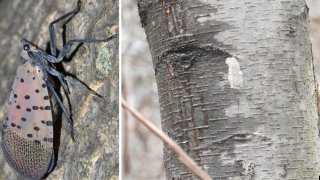
A small breeding population of an invasive insect that can damage native trees and crops has been found in Massachusetts for the first time, state agricultural officials said.
The spotted lanternfly population was found in Fitchburg, close to where a lanternfly nymph was reported earlier this summer, according to a statement Tuesday from the state Department of Agricultural Resources.
The infestation is limited to a single cluster of three trees, and inspectors are extensively surveying the area. While individual lanternflies have been found in several areas of the state in recent years, this is the first evidence that Massachusetts has a breeding population, the agency said.
“The spotted lanternfly can have devastating impacts on Massachusetts’ agricultural industry, including on a number of farms and orchards in this part of the state that we want to protect from this pest,” agency Commissioner John Lebeaux said in a statement.
Get New England news, weather forecasts and entertainment stories to your inbox. Sign up for NECN newsletters.
The origin of the infestation is unclear because the insects, native to Asia, can hitch a ride on vehicles and trains, or on interstate shipments of agricultural and landscaping products.
They attack many different trees, including maples and walnuts, as well as shrubs and vines, and have the potential to damage a range of agricultural products, including apples, peaches, grapes, hops and ornamental plants.
Lebeaux urged the public to report sightings of the bug to the state — both the gray adult insects that are about one-inch (2 centimeters) long with black spots and red underwings, as well as the inch-long, yellowish-brown, rectangular egg masses.
Local
The insects were first found in the United States in 2014 in Pennsylvania and have since been detected in Connecticut, Delaware, Indiana, Maryland, New Jersey, New York, Ohio, Virginia and West Virginia.



